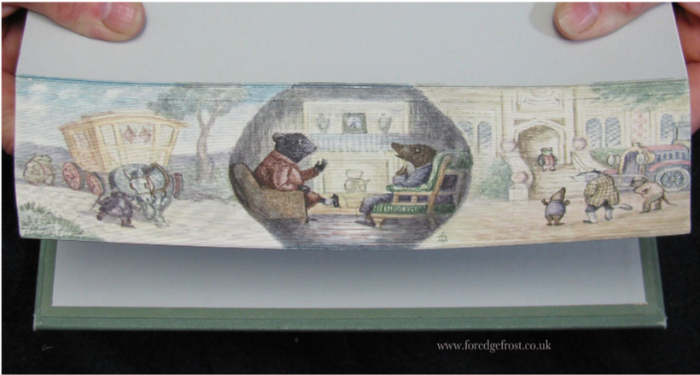
These Books have an Edgy Secret: A History and Gallery of Fore-Edge Painting and Art
If you are new to the world of fore-edge paintings, you are in for a treat. If you have ever looked at a book with a painting on the edge of the pages (AKA the fore-edge), you have seen fore-edge paintings. They are one aspect of book history that blends into art history. In my humble opinion, they are an important bit of book magic.
In the 1650s, London bookbinders Stephen and Thomas Lewis, added fore-edge paintings to their books. By painting the edge while they were angled, customers could see the paintings when the book was fanned out and see only the gilded edges when the books were closed. John Ansley, a researcher on the subject of fore-edge paintings, explains the two theories as to the origin of the technique. Either the paintings started as a way to help identify books that were placed horizontally in libraries with the pages out, similar to the interior design trend on HGTV, or they started as a way for bookbinders to show off and glam up every part of their product.
However, the trend began, the fore-edge painting techniques preserved the visibility of both the text and the fore-edge painting. The process of painting the fore-edge of a book was not easy, to say the least. Watercolor painters clamped the pages together at an angle before they used almost-dry brushes to paint an image on the pages and gild or marble the flat edges once the painting dried. If their brushes were too wet, artists risked marring the text on the page. If the gild was applied too quickly or at the wrong angle, the artist could damage or lose the fore-edge painting that already used the painter’s time and materials. Fore-edge painters had to know their craft if they wanted to create a viable final product for their customers.
Although other stationers and booksellers applied fore-edge paintings to their books in the later half of the 1600s, the rise in the popularity of the technique did not come until the late 1700s. The Edwardses of Halifax applied fore-edge paintings on the books in their shops. Fore-edge paintings became a part of a book’s paratext that helped bookbinders use artistry to sell their wares.
How To Find A Fore-Edge Painting Today
There are quite a few copies of books with fore-edge paintings in libraries’ special collections. In the past, documenting the book history of fore-edge paintings was done in books like Fore-edge painting; a historical survey of a curious art in book decoration by Carl J. Weber, the curator of rare books at Colby College in the mid 1900s.
Today, librarians, book curators, and book historians have done their best to share these books digitally. Looking at fore-edge paintings once required the public to have the credentials to access the collections and the ability to visit the books in person. Today institutions like The New York Historical Society have done some wonderful work capturing their collection via gif.
Books with Fore-Edge Paintings On Your Socials
Given the visual impact of the splayed edges, it is unsurprising that book collectors and modern fore-edge painters have created popular content on Booktok. The platform gives book collectors and sellers the ability to show off and explain the books in their collections with fore-edge paintings.
The account @thedogearedbook shows off an example of a book from 1847 with a fore-edge painting with a man’s face next to a house that has fluffy, green trees next to a home when the pages are splayed out and gilded edges when the book is closed.
Historically, there have been a few trends in the fore-edge painting biz, and the advent of social media has helped everyone document it a bit easier. We have double fore-edge paintings, triple fore-edge paintings, panoramic fore-edge paintings, and split double fore-edge paintings. Then we cannot forget the notable female artists and Chinese artists that have made their mark on the history of fore-edge paintings. While they each use different techniques, I promise it’s all lovely.
Double Fore-Edge Painting and Triple Fore-Edge Painting
Double fore-edge paintings included not one but two paintings on the fore-edge. When you fan the book one way, you see painting number 1, then you fan the book the other way, and here comes painting number 2. This style is both difficult to produce and rare to find. Luckily, there are some digitized examples on both TikTok and Pinterest.
The @pbagalleries account also has a lovely example of a double fore-edge painting on this collected edition of Hood’s Works containing the writing of Thomas Hood from the 1800s. Each way the book fans shows a different image of a town.
Triple fore-edge paintings added a third image to the flat edge of the pages instead of marbling or gilding the edges. It took a high skill level to allow all three images to dry without affecting each other.
Panoramic Fore-Edge Painting
Panoramic fore-edge paintings wrap around all three sides of the edges of the pages to imitate a panoramic view of the scene. Although this is an 1880s edition of The Book of the Thames by Alan Jenkins, the panoramic scene of the Thames river was painted by Martin Frost relatively recently.
Split Double Fore-Edge Painting
Then, split double paintings can only be seen when you open the book at the center. Either side reveals two separate illustrations with this technique. This pocket-sized bible from 1846 that was shared by @moonsrarebooks has a split double fore-edge painting. The book is small, but the heavily detailed edge shows both the nativity and the crucifixion when opened at the center.
Female Fore-Edge Painters
A renowned fore-edge painter, Miss C.B. Currie (1849-1940) painted, signed, and numbered her entire body of work, an impressive 172 books. In an industry of mostly anonymous artists, Currie’s signatures stand out. The antiquarian bookseller, @tomwayling, provides a brief history of fore-edge paintings and quite a few examples of volumes from the 1580s as well as books painted by the lady of legend, Miss C. B. Currie.
Chinese Fore-Edge Painters
In the 1900s, Chinese artists at the Catholic University in Peking added fore-edge paintings to books in their collection after western artists introduced the practice. However, the fore-edge painting on the Chinese text, San cai tu hui 三才 圖會 from 1609 comes from the University of Iowa Special Collections. Although most book historians note religious imagery appears on extant copies of Chinese fore-edge paintings, the image of does not appear to depict a religious scene. It just goes to show you special collections is a truly remarkable place.
The Questions of Quality in the Late 1800s
Ansley notes an American influence on the fore-edge painting business that led to a decrease in quality overall in the late 1800s. The problems included but were not limited to: an increase in price and decrease in quality, books with paintings that had nothing to do with the edges, and booksellers painting their backstock in the hopes of selling poor-performing novels. Honestly, I am not surprised an artistic tool designed to sell books was exploited more and more for profit over time. Ideally, the illustrations spoke to the content of the book or the owner of the book like this image of a gentleman playing chess. However, this level of artistry was no longer the norm.
Although fore-edge painters have maintained the art over the centuries, the widespread demand for the paintings has decreased in the last 200 years. Artists like Martin Frost have over 40 years of experience in the field, but more recently, artists on Instagram and Tiktok have begun to practice fore-edge painting and share their processes with their followers.
Today’s Fore-Edge Painters are On Your Socials, Too
Relatively short videos of artists painting the edges of books and displaying the final product have captured the imagination and attention of audiences everywhere. In my research, I noted the overwhelming popularity of painting large fantasy novels, so let’s take a look at them.
I can see the appeal of applying an old art form to a book like J.R.R. Tolkien’s Lord of the Rings, which was inspired by medieval literature. It also helps that artists have a lot of real estate to work with on the sides of books with hundreds of pages — not to mention the book’s popularity helps with post visibility. With over half a million followers as of now, @maisie_matilda is a particularly popular and talented artist who paints the fore-edges of many books by J.R.R. Tolkien.
Artists on Booktok also do amazing work with other beefy books written by Sarah J. Maas. Many members of the Booktok community love Maas, so I was not surprised to find more than one creator inspired to paint the edges of books. The creator @i_ambooked shows her attention to recreating detailed landscapes from The Court of Silver Flames.
The artist @brimariepaints even gilds the edges of her fore-edge painting on A Court of Mist and Fury. The hidden fore-edge painting effect looks wonderful here.
Romance lovers might also be happy to find @rainiegirl369 has painted a copy of Book Lovers by Emily Henry.
However, I would like to note it can be difficult to find fore-edge painters who paint diverse novels. So, I hold a special place in my heart for fore-edge artists who have painted more diverse fantasy novels. @books_and_bubs created an aquatic design on Skin of the Sea by Natasha Bowen.
As well as @zeldaslibrary who has painted The Jasmine Throne by Tasha Suri. I love to see how the creeping vine design on the fore-edges matches the magic at work in the book.
There are still plenty of fore-edge painters on Booktok are working on beautifying the edges of the classics. @firenze_flo adds gorgeous fore-edge paintings to classics like Pride and Prejudice by Jane Austin. The fact that she is inspired by one of the better movie adaptations is just a perk.
Here, @alice_diogenes painted a wonderful landscape on the fore-edges of Wuthering Heights by Emily Brontë.
Where are Fore-Edge Paintings Going Next?
In my humble opinion, fore-edge paintings are an important bit of book magic that is here to say. Even if it is only through my overwhelming enthusiasm, I think we have a shot. Book historians, booksellers, librarians, book collectors, and even the everyday reader deserve to feel glee when they experience the beauty of both the words on the page and the book as an object.
Fore-edge painters continue to beautify the entirety of the book as an extension of their passion for the material. The edges of books provide artists with the opportunity to embellish books for themselves or their clients. Either way, I am happy to find new and old fore-edge paintings that continue to surprise me. I want to learn these books’ edgy secrets. Even if those secrets are small paintings we hide on the sides of the pages.












